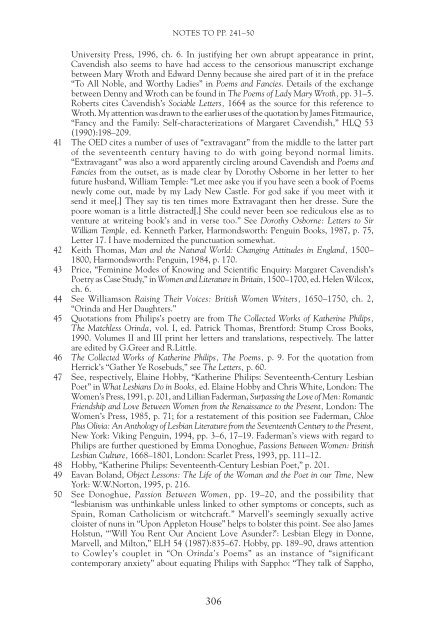ENG LYRIC POETRY.pdf - STIBA Malang
ENG LYRIC POETRY.pdf - STIBA Malang
ENG LYRIC POETRY.pdf - STIBA Malang
Create successful ePaper yourself
Turn your PDF publications into a flip-book with our unique Google optimized e-Paper software.
NOTES TO PP. 241–50<br />
University Press, 1996, ch. 6. In justifying her own abrupt appearance in print,<br />
Cavendish also seems to have had access to the censorious manuscript exchange<br />
between Mary Wroth and Edward Denny because she aired part of it in the preface<br />
“To All Noble, and Worthy Ladies” in Poems and Fancies. Details of the exchange<br />
between Denny and Wroth can be found in The Poems of Lady Mary Wroth, pp. 31–5.<br />
Roberts cites Cavendish’s Sociable Letters, 1664 as the source for this reference to<br />
Wroth. My attention was drawn to the earlier uses of the quotation by James Fitzmaurice,<br />
“Fancy and the Family: Self-characterizations of Margaret Cavendish,” HLQ 53<br />
(1990):198–209.<br />
41 The OED cites a number of uses of “extravagant” from the middle to the latter part<br />
of the seventeenth century having to do with going beyond normal limits.<br />
“Extravagant” was also a word apparently circling around Cavendish and Poems and<br />
Fancies from the outset, as is made clear by Dorothy Osborne in her letter to her<br />
future husband, William Temple: “Let mee aske you if you have seen a book of Poems<br />
newly come out, made by my Lady New Castle. For god sake if you meet with it<br />
send it mee[.] They say tis ten times more Extravagant then her dresse. Sure the<br />
poore woman is a little distracted[.] She could never been soe rediculous else as to<br />
venture at writeing book’s and in verse too.” See Dorothy Osborne: Letters to Sir<br />
William Temple, ed. Kenneth Parker, Harmondsworth: Penguin Books, 1987, p. 75,<br />
Letter 17. I have modernized the punctuation somewhat.<br />
42 Keith Thomas, Man and the Natural World: Changing Attitudes in England, 1500–<br />
1800, Harmondsworth: Penguin, 1984, p. 170.<br />
43 Price, “Feminine Modes of Knowing and Scientific Enquiry: Margaret Cavendish’s<br />
Poetry as Case Study,” in Women and Literature in Britain, 1500–1700, ed. Helen Wilcox,<br />
ch. 6.<br />
44 See Williamson Raising Their Voices: British Women Writers, 1650–1750, ch. 2,<br />
“Orinda and Her Daughters.”<br />
45 Quotations from Philips’s poetry are from The Collected Works of Katherine Philips,<br />
The Matchless Orinda, vol. I, ed. Patrick Thomas, Brentford: Stump Cross Books,<br />
1990. Volumes II and III print her letters and translations, respectively. The latter<br />
are edited by G.Greer and R.Little.<br />
46 The Collected Works of Katherine Philips, The Poems, p. 9. For the quotation from<br />
Herrick’s “Gather Ye Rosebuds,” see The Letters, p. 60.<br />
47 See, respectively, Elaine Hobby, “Katherine Philips: Seventeenth-Century Lesbian<br />
Poet” in What Lesbians Do in Books, ed. Elaine Hobby and Chris White, London: The<br />
Women’s Press, 1991, p. 201, and Lillian Faderman, Surpassing the Love of Men: Romantic<br />
Friendship and Love Between Women from the Renaissance to the Present, London: The<br />
Women’s Press, 1985, p. 71; for a restatement of this position see Faderman, Chloe<br />
Plus Olivia: An Anthology of Lesbian Literature from the Seventeenth Century to the Present,<br />
New York: Viking Penguin, 1994, pp. 3–6, 17–19. Faderman’s views with regard to<br />
Philips are further questioned by Emma Donoghue, Passions Between Women: British<br />
Lesbian Culture, 1668–1801, London: Scarlet Press, 1993, pp. 111–12.<br />
48 Hobby, “Katherine Philips: Seventeenth-Century Lesbian Poet,” p. 201.<br />
49 Eavan Boland, Object Lessons: The Life of the Woman and the Poet in our Time, New<br />
York: W.W.Norton, 1995, p. 216.<br />
50 See Donoghue, Passion Between Women, pp. 19–20, and the possibility that<br />
“lesbianism was unthinkable unless linked to other symptoms or concepts, such as<br />
Spain, Roman Catholicism or witchcraft.” Marvell’s seemingly sexually active<br />
cloister of nuns in “Upon Appleton House” helps to bolster this point. See also James<br />
Holstun, “‘Will You Rent Our Ancient Love Asunder?’: Lesbian Elegy in Donne,<br />
Marvell, and Milton,” ELH 54 (1987):835–67. Hobby, pp. 189–90, draws attention<br />
to Cowley’s couplet in “On Orinda’s Poems” as an instance of “significant<br />
contemporary anxiety” about equating Philips with Sappho: “They talk of Sappho,<br />
306










